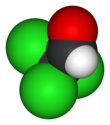| |||
| Names | |||
|---|---|---|---|
| Preferred IUPAC name
Trichloroacetaldehyde | |||
| Other names
Trichloroethanal
| |||
| Identifiers | |||
3D model (JSmol)
|
|||
| 506422 | |||
| ChEBI | |||
| ChEMBL | |||
| ChemSpider | |||
| DrugBank | |||
| ECHA InfoCard | 100.000.829 | ||
| EC Number |
| ||
| KEGG | |||
PubChem CID
|
|||
| UNII | |||
CompTox Dashboard (EPA)
|
|||
| |||
| |||
| Properties | |||
| C2HCl3O | |||
| Molar mass | 147.38 g·mol−1 | ||
| Appearance | Colorless liquid | ||
| Odor | Pungent and irritating | ||
| Density | 1.404 g/cm3 | ||
| Melting point | −57.5 °C (−71.5 °F; 215.7 K) | ||
| Boiling point | 97.8 °C (208.0 °F; 370.9 K) | ||
| Forms soluble hydrate | |||
| Solubility in ethanol | Miscible | ||
| Solubility in diethyl ether | Miscible | ||
| Solubility in chloroform | Miscible | ||
| Acidity (pKa) | 9.66 | ||
| −6.77×10−5 cm3/mol | |||
Refractive index (nD)
|
9.48846 | ||
| Hazards | |||
| GHS labelling: | |||
 
| |||
| Danger | |||
| H301, H302, H315, H319, H335 | |||
| P261, P264, P270, P271, P280, P301+P310, P301+P312, P302+P352, P304+P340, P305+P351+P338, P312, P321, P330, P332+P313, P337+P313, P362, P403+P233, P405, P501 | |||
| Lethal dose or concentration (LD, LC): | |||
LD50 (median dose)
|
480 mg/kg (rat, oral) | ||
| Related compounds | |||
Related compounds
|
Fluoral, Bromal, Iodal | ||
Except where otherwise noted, data are given for materials in their standard state (at 25 °C [77 °F], 100 kPa).
| |||
Chloral, also known as trichloroacetaldehyde or trichloroethanal, is the organic compound with the formula Cl3CCHO. This aldehyde is a colourless liquid that is soluble in a wide range of solvents. It reacts with water to form chloral hydrate, a once widely used sedative and hypnotic substance.[1]
- ^ Luknitskii, F. I. (1975). "Chemistry of Chloral". Chemical Reviews. 75 (3): 259–289. doi:10.1021/cr60295a001.

